Financial Performance Analysis of Companies
VerifiedAdded on 2020/06/06
|14
|2992
|61
AI Summary
This assignment delves into the analysis of financial performance, specifically focusing on comparing value and growth investing strategies. It utilizes ratio analysis tools to evaluate the financial position and performance of selected companies from various perspectives. The research includes discussions on methodologies, limitations, ethical considerations, data analysis findings, and concludes with recommendations based on the insights gained.
Contribute Materials
Your contribution can guide someone’s learning journey. Share your
documents today.

Dissertation Title: Value Investing in stock markets and
related risks.
1
related risks.
1
Secure Best Marks with AI Grader
Need help grading? Try our AI Grader for instant feedback on your assignments.

TABLE OF CONTENTS
CHAPTER 1: INTRODUCTION....................................................................................................1
Background of the study..............................................................................................................1
Research aim and objectives........................................................................................................1
Research Questions......................................................................................................................2
Rationale of the study..................................................................................................................2
Significance of the study.............................................................................................................2
CHAPTER 2: LITRTATURE REVIEW.........................................................................................4
Value investing and its approaches..............................................................................................4
Indicators of value investing approaches.....................................................................................5
CHAPTER 3: RESEARCH METHODOLOGY.............................................................................7
Research type...............................................................................................................................7
Research approach.......................................................................................................................7
Research philosophy....................................................................................................................7
Data collection.............................................................................................................................7
Sampling......................................................................................................................................7
Data analysis................................................................................................................................7
Research limitations.....................................................................................................................8
Reliability and validity................................................................................................................8
Ethical considerations..................................................................................................................8
CHAPTER 4: DATA ANALYSIS AND FINDINGS.....................................................................9
CHAPTER 5: CONCLUSION AND RECOMMENDATIONS...................................................10
REFERENCES..............................................................................................................................11
2
CHAPTER 1: INTRODUCTION....................................................................................................1
Background of the study..............................................................................................................1
Research aim and objectives........................................................................................................1
Research Questions......................................................................................................................2
Rationale of the study..................................................................................................................2
Significance of the study.............................................................................................................2
CHAPTER 2: LITRTATURE REVIEW.........................................................................................4
Value investing and its approaches..............................................................................................4
Indicators of value investing approaches.....................................................................................5
CHAPTER 3: RESEARCH METHODOLOGY.............................................................................7
Research type...............................................................................................................................7
Research approach.......................................................................................................................7
Research philosophy....................................................................................................................7
Data collection.............................................................................................................................7
Sampling......................................................................................................................................7
Data analysis................................................................................................................................7
Research limitations.....................................................................................................................8
Reliability and validity................................................................................................................8
Ethical considerations..................................................................................................................8
CHAPTER 4: DATA ANALYSIS AND FINDINGS.....................................................................9
CHAPTER 5: CONCLUSION AND RECOMMENDATIONS...................................................10
REFERENCES..............................................................................................................................11
2
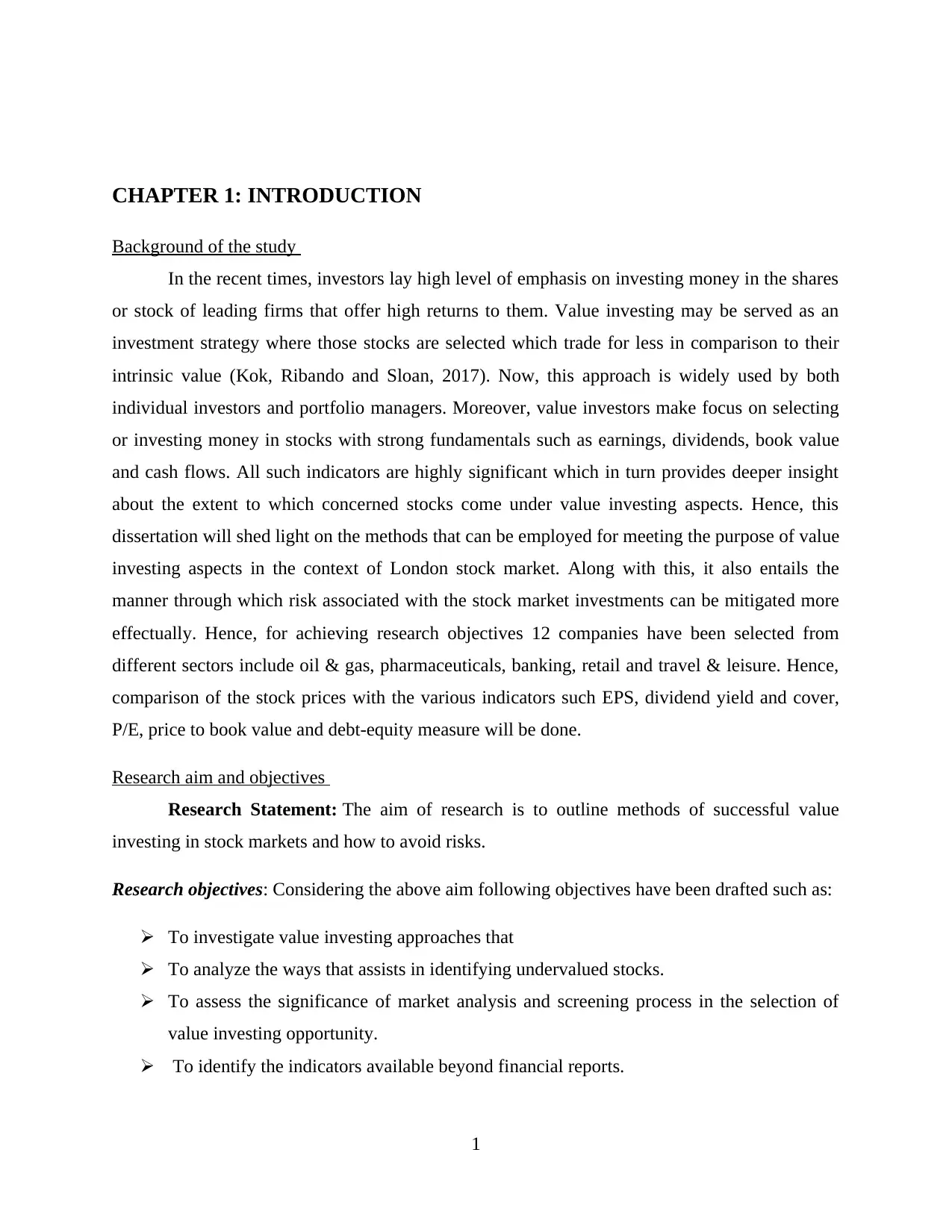
CHAPTER 1: INTRODUCTION
Background of the study
In the recent times, investors lay high level of emphasis on investing money in the shares
or stock of leading firms that offer high returns to them. Value investing may be served as an
investment strategy where those stocks are selected which trade for less in comparison to their
intrinsic value (Kok, Ribando and Sloan, 2017). Now, this approach is widely used by both
individual investors and portfolio managers. Moreover, value investors make focus on selecting
or investing money in stocks with strong fundamentals such as earnings, dividends, book value
and cash flows. All such indicators are highly significant which in turn provides deeper insight
about the extent to which concerned stocks come under value investing aspects. Hence, this
dissertation will shed light on the methods that can be employed for meeting the purpose of value
investing aspects in the context of London stock market. Along with this, it also entails the
manner through which risk associated with the stock market investments can be mitigated more
effectually. Hence, for achieving research objectives 12 companies have been selected from
different sectors include oil & gas, pharmaceuticals, banking, retail and travel & leisure. Hence,
comparison of the stock prices with the various indicators such EPS, dividend yield and cover,
P/E, price to book value and debt-equity measure will be done.
Research aim and objectives
Research Statement: The aim of research is to outline methods of successful value
investing in stock markets and how to avoid risks.
Research objectives: Considering the above aim following objectives have been drafted such as:
To investigate value investing approaches that
To analyze the ways that assists in identifying undervalued stocks.
To assess the significance of market analysis and screening process in the selection of
value investing opportunity.
To identify the indicators available beyond financial reports.
1
Background of the study
In the recent times, investors lay high level of emphasis on investing money in the shares
or stock of leading firms that offer high returns to them. Value investing may be served as an
investment strategy where those stocks are selected which trade for less in comparison to their
intrinsic value (Kok, Ribando and Sloan, 2017). Now, this approach is widely used by both
individual investors and portfolio managers. Moreover, value investors make focus on selecting
or investing money in stocks with strong fundamentals such as earnings, dividends, book value
and cash flows. All such indicators are highly significant which in turn provides deeper insight
about the extent to which concerned stocks come under value investing aspects. Hence, this
dissertation will shed light on the methods that can be employed for meeting the purpose of value
investing aspects in the context of London stock market. Along with this, it also entails the
manner through which risk associated with the stock market investments can be mitigated more
effectually. Hence, for achieving research objectives 12 companies have been selected from
different sectors include oil & gas, pharmaceuticals, banking, retail and travel & leisure. Hence,
comparison of the stock prices with the various indicators such EPS, dividend yield and cover,
P/E, price to book value and debt-equity measure will be done.
Research aim and objectives
Research Statement: The aim of research is to outline methods of successful value
investing in stock markets and how to avoid risks.
Research objectives: Considering the above aim following objectives have been drafted such as:
To investigate value investing approaches that
To analyze the ways that assists in identifying undervalued stocks.
To assess the significance of market analysis and screening process in the selection of
value investing opportunity.
To identify the indicators available beyond financial reports.
1
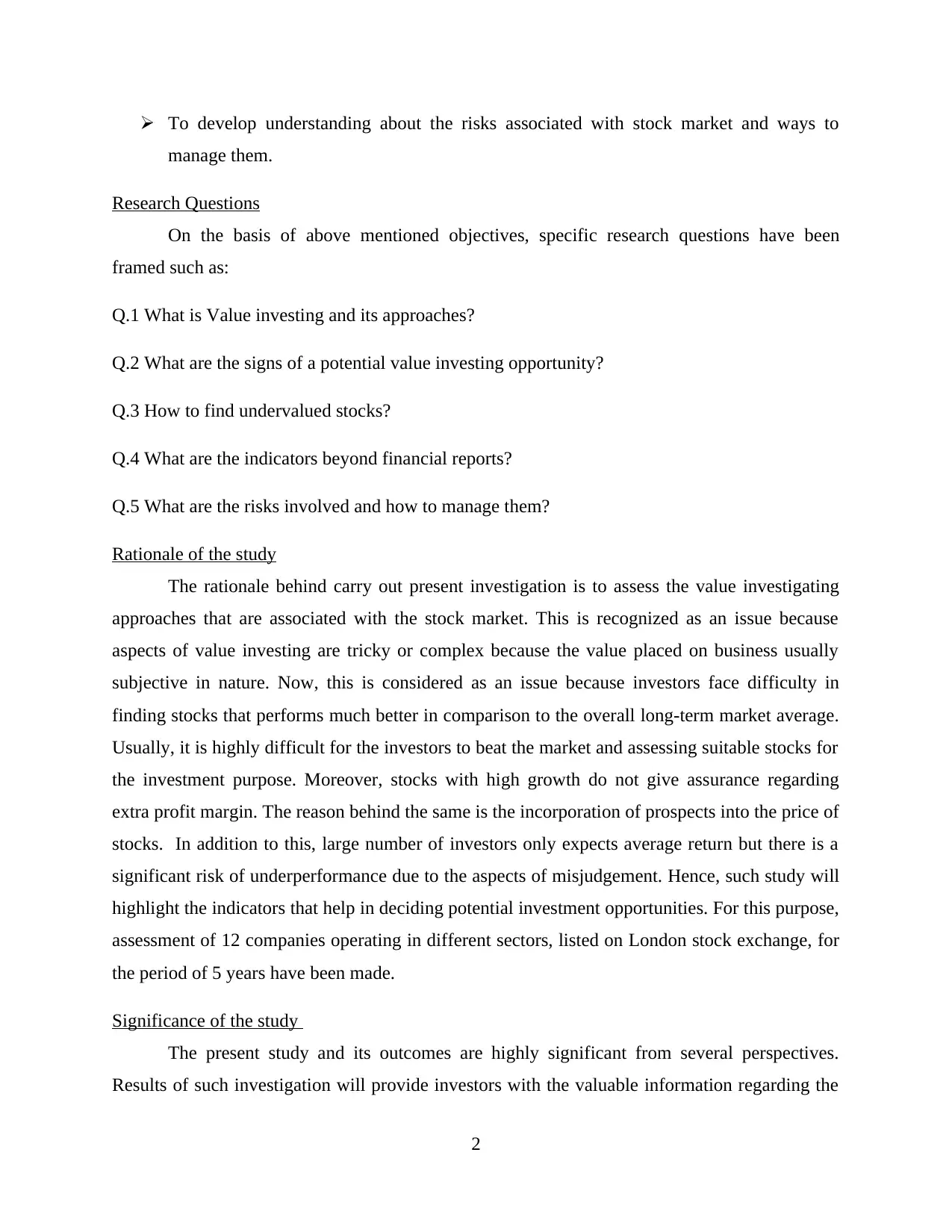
To develop understanding about the risks associated with stock market and ways to
manage them.
Research Questions
On the basis of above mentioned objectives, specific research questions have been
framed such as:
Q.1 What is Value investing and its approaches?
Q.2 What are the signs of a potential value investing opportunity?
Q.3 How to find undervalued stocks?
Q.4 What are the indicators beyond financial reports?
Q.5 What are the risks involved and how to manage them?
Rationale of the study
The rationale behind carry out present investigation is to assess the value investigating
approaches that are associated with the stock market. This is recognized as an issue because
aspects of value investing are tricky or complex because the value placed on business usually
subjective in nature. Now, this is considered as an issue because investors face difficulty in
finding stocks that performs much better in comparison to the overall long-term market average.
Usually, it is highly difficult for the investors to beat the market and assessing suitable stocks for
the investment purpose. Moreover, stocks with high growth do not give assurance regarding
extra profit margin. The reason behind the same is the incorporation of prospects into the price of
stocks. In addition to this, large number of investors only expects average return but there is a
significant risk of underperformance due to the aspects of misjudgement. Hence, such study will
highlight the indicators that help in deciding potential investment opportunities. For this purpose,
assessment of 12 companies operating in different sectors, listed on London stock exchange, for
the period of 5 years have been made.
Significance of the study
The present study and its outcomes are highly significant from several perspectives.
Results of such investigation will provide investors with the valuable information regarding the
2
manage them.
Research Questions
On the basis of above mentioned objectives, specific research questions have been
framed such as:
Q.1 What is Value investing and its approaches?
Q.2 What are the signs of a potential value investing opportunity?
Q.3 How to find undervalued stocks?
Q.4 What are the indicators beyond financial reports?
Q.5 What are the risks involved and how to manage them?
Rationale of the study
The rationale behind carry out present investigation is to assess the value investigating
approaches that are associated with the stock market. This is recognized as an issue because
aspects of value investing are tricky or complex because the value placed on business usually
subjective in nature. Now, this is considered as an issue because investors face difficulty in
finding stocks that performs much better in comparison to the overall long-term market average.
Usually, it is highly difficult for the investors to beat the market and assessing suitable stocks for
the investment purpose. Moreover, stocks with high growth do not give assurance regarding
extra profit margin. The reason behind the same is the incorporation of prospects into the price of
stocks. In addition to this, large number of investors only expects average return but there is a
significant risk of underperformance due to the aspects of misjudgement. Hence, such study will
highlight the indicators that help in deciding potential investment opportunities. For this purpose,
assessment of 12 companies operating in different sectors, listed on London stock exchange, for
the period of 5 years have been made.
Significance of the study
The present study and its outcomes are highly significant from several perspectives.
Results of such investigation will provide investors with the valuable information regarding the
2
Secure Best Marks with AI Grader
Need help grading? Try our AI Grader for instant feedback on your assignments.
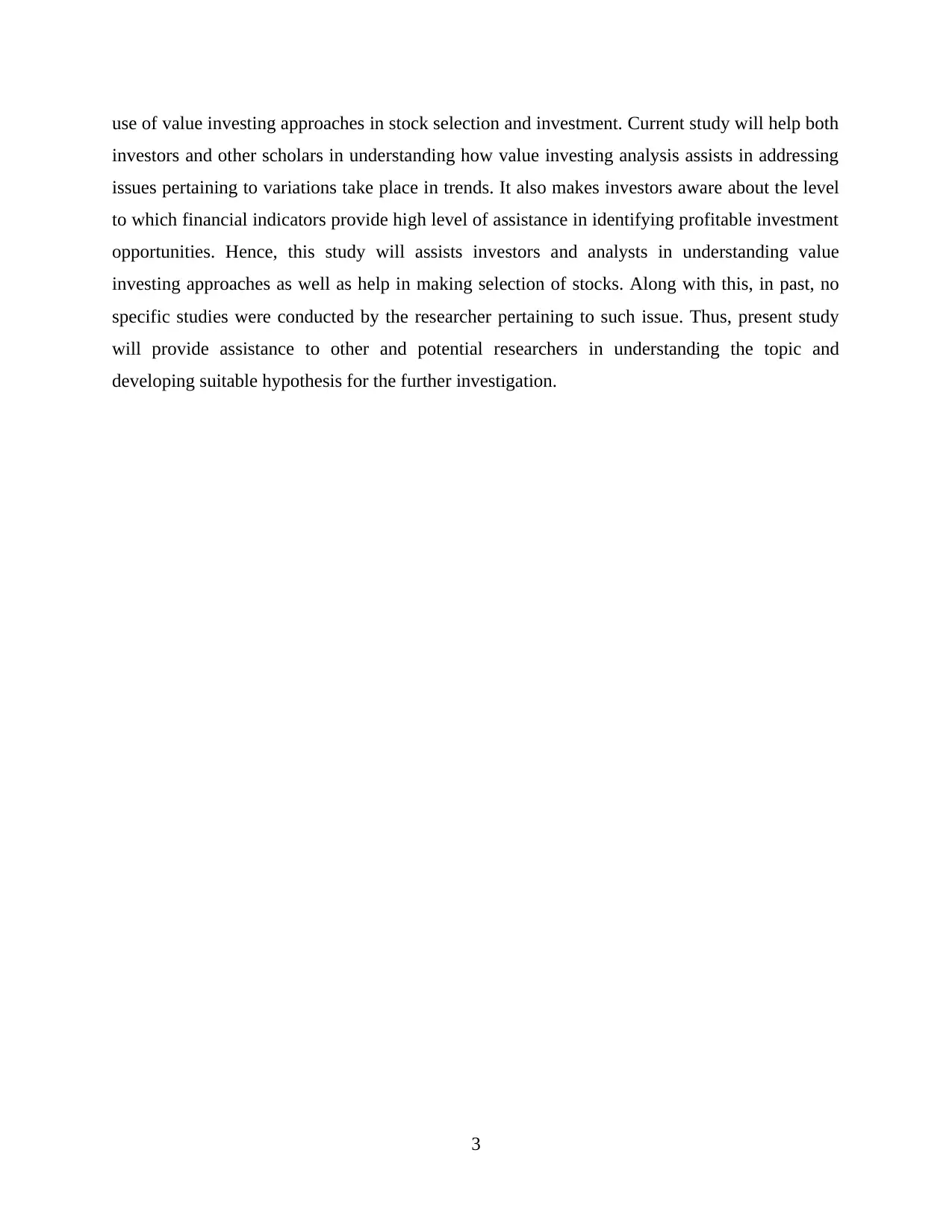
use of value investing approaches in stock selection and investment. Current study will help both
investors and other scholars in understanding how value investing analysis assists in addressing
issues pertaining to variations take place in trends. It also makes investors aware about the level
to which financial indicators provide high level of assistance in identifying profitable investment
opportunities. Hence, this study will assists investors and analysts in understanding value
investing approaches as well as help in making selection of stocks. Along with this, in past, no
specific studies were conducted by the researcher pertaining to such issue. Thus, present study
will provide assistance to other and potential researchers in understanding the topic and
developing suitable hypothesis for the further investigation.
3
investors and other scholars in understanding how value investing analysis assists in addressing
issues pertaining to variations take place in trends. It also makes investors aware about the level
to which financial indicators provide high level of assistance in identifying profitable investment
opportunities. Hence, this study will assists investors and analysts in understanding value
investing approaches as well as help in making selection of stocks. Along with this, in past, no
specific studies were conducted by the researcher pertaining to such issue. Thus, present study
will provide assistance to other and potential researchers in understanding the topic and
developing suitable hypothesis for the further investigation.
3
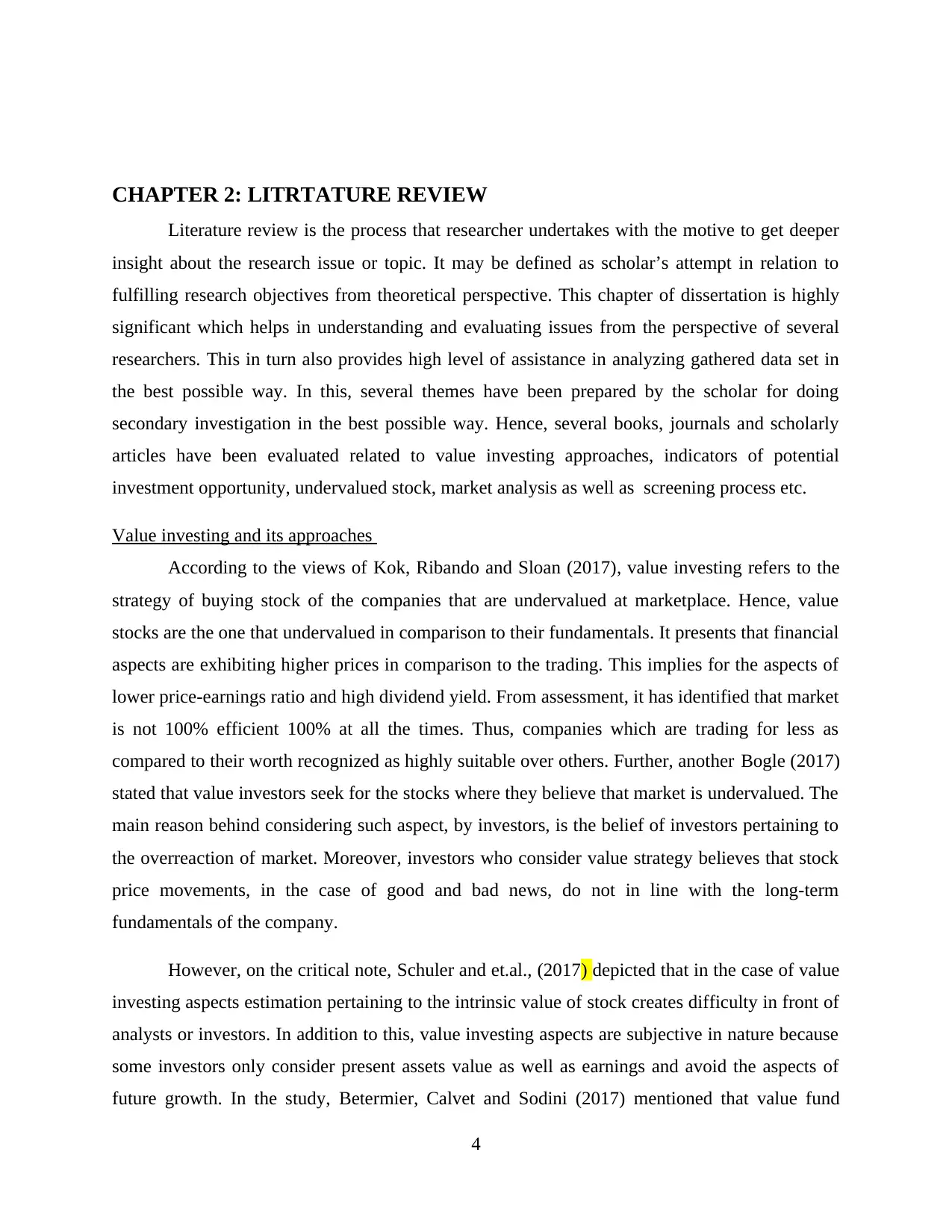
CHAPTER 2: LITRTATURE REVIEW
Literature review is the process that researcher undertakes with the motive to get deeper
insight about the research issue or topic. It may be defined as scholar’s attempt in relation to
fulfilling research objectives from theoretical perspective. This chapter of dissertation is highly
significant which helps in understanding and evaluating issues from the perspective of several
researchers. This in turn also provides high level of assistance in analyzing gathered data set in
the best possible way. In this, several themes have been prepared by the scholar for doing
secondary investigation in the best possible way. Hence, several books, journals and scholarly
articles have been evaluated related to value investing approaches, indicators of potential
investment opportunity, undervalued stock, market analysis as well as screening process etc.
Value investing and its approaches
According to the views of Kok, Ribando and Sloan (2017), value investing refers to the
strategy of buying stock of the companies that are undervalued at marketplace. Hence, value
stocks are the one that undervalued in comparison to their fundamentals. It presents that financial
aspects are exhibiting higher prices in comparison to the trading. This implies for the aspects of
lower price-earnings ratio and high dividend yield. From assessment, it has identified that market
is not 100% efficient 100% at all the times. Thus, companies which are trading for less as
compared to their worth recognized as highly suitable over others. Further, another Bogle (2017)
stated that value investors seek for the stocks where they believe that market is undervalued. The
main reason behind considering such aspect, by investors, is the belief of investors pertaining to
the overreaction of market. Moreover, investors who consider value strategy believes that stock
price movements, in the case of good and bad news, do not in line with the long-term
fundamentals of the company.
However, on the critical note, Schuler and et.al., (2017) depicted that in the case of value
investing aspects estimation pertaining to the intrinsic value of stock creates difficulty in front of
analysts or investors. In addition to this, value investing aspects are subjective in nature because
some investors only consider present assets value as well as earnings and avoid the aspects of
future growth. In the study, Betermier, Calvet and Sodini (2017) mentioned that value fund
4
Literature review is the process that researcher undertakes with the motive to get deeper
insight about the research issue or topic. It may be defined as scholar’s attempt in relation to
fulfilling research objectives from theoretical perspective. This chapter of dissertation is highly
significant which helps in understanding and evaluating issues from the perspective of several
researchers. This in turn also provides high level of assistance in analyzing gathered data set in
the best possible way. In this, several themes have been prepared by the scholar for doing
secondary investigation in the best possible way. Hence, several books, journals and scholarly
articles have been evaluated related to value investing approaches, indicators of potential
investment opportunity, undervalued stock, market analysis as well as screening process etc.
Value investing and its approaches
According to the views of Kok, Ribando and Sloan (2017), value investing refers to the
strategy of buying stock of the companies that are undervalued at marketplace. Hence, value
stocks are the one that undervalued in comparison to their fundamentals. It presents that financial
aspects are exhibiting higher prices in comparison to the trading. This implies for the aspects of
lower price-earnings ratio and high dividend yield. From assessment, it has identified that market
is not 100% efficient 100% at all the times. Thus, companies which are trading for less as
compared to their worth recognized as highly suitable over others. Further, another Bogle (2017)
stated that value investors seek for the stocks where they believe that market is undervalued. The
main reason behind considering such aspect, by investors, is the belief of investors pertaining to
the overreaction of market. Moreover, investors who consider value strategy believes that stock
price movements, in the case of good and bad news, do not in line with the long-term
fundamentals of the company.
However, on the critical note, Schuler and et.al., (2017) depicted that in the case of value
investing aspects estimation pertaining to the intrinsic value of stock creates difficulty in front of
analysts or investors. In addition to this, value investing aspects are subjective in nature because
some investors only consider present assets value as well as earnings and avoid the aspects of
future growth. In the study, Betermier, Calvet and Sodini (2017) mentioned that value fund
4

managers are usually looking for the companies that have good or strong fundamentals
irrespective of their reducing trend or pattern. Value stocks are usually found in the industries
where cyclical fluctuations take place. Hence, value stocks may do well only in an economic
recovery but more like to lag in a bull market. Thus, it can be presented that value investing
aspects are quite simple which lays emphasis on making selection of undervalued stocks. This
aspect clearly exhibits that such kind of strategies are looking for inefficiencies at the
marketplace and thereby helps in taking advantages of general market sentiments.
Author assessed in their study that in selection of stock in accordance with value
investing approaches are highly significant in which stock selection is highly based on the
comparative results in relation to stock price and intrinsic value. Such approach places emphasis
on stock selection by reviewing or examining company’s fundamentals such as return on equity,
price-earnings ratio etc. This in turn provides high level of assistance to the investor in making
appropriate estimation about company’s growth. Stock which is selected on the basis of value
investing approach offers results in terms of profit margin under several years.
Indicators of value investing approaches
According to the views of Cronqvist, Siegel and Yu (2015), emphasis should be placed
on investing money with margin of safety. Considering Graham approach author entailed that an
investor should purchase securities when market prices are below as compared to the intrinsic
value. Hence, fundamental principle of value investing entails that focus needs be placed on
assessing stocks that worth more in against to the prices reflected or prevail in the market.
Further, Davis (2017) depicted in their study that, by keeping in mind Graham’s framework,
prices of the stock market are the reflection of demand & supply. Irrational market behaviour is
one of the main cause due to which aspects of demand & supply are affected and thereby share
price. For example: In the times of greed, investors place high level of emphasis on purchasing
stocks, whereas prefers to sell stock during panic situation. This situation offers high level of
benefits to the value investors. In other words, market irrationality offers opportunity to the value
investors in relation to buying stock that falls below the level of intrinsic value. Thus, as per
Graham approach or framework, by investing money in the undervalued stock investors can earn
huge profit when market enhances in the near future.
5
irrespective of their reducing trend or pattern. Value stocks are usually found in the industries
where cyclical fluctuations take place. Hence, value stocks may do well only in an economic
recovery but more like to lag in a bull market. Thus, it can be presented that value investing
aspects are quite simple which lays emphasis on making selection of undervalued stocks. This
aspect clearly exhibits that such kind of strategies are looking for inefficiencies at the
marketplace and thereby helps in taking advantages of general market sentiments.
Author assessed in their study that in selection of stock in accordance with value
investing approaches are highly significant in which stock selection is highly based on the
comparative results in relation to stock price and intrinsic value. Such approach places emphasis
on stock selection by reviewing or examining company’s fundamentals such as return on equity,
price-earnings ratio etc. This in turn provides high level of assistance to the investor in making
appropriate estimation about company’s growth. Stock which is selected on the basis of value
investing approach offers results in terms of profit margin under several years.
Indicators of value investing approaches
According to the views of Cronqvist, Siegel and Yu (2015), emphasis should be placed
on investing money with margin of safety. Considering Graham approach author entailed that an
investor should purchase securities when market prices are below as compared to the intrinsic
value. Hence, fundamental principle of value investing entails that focus needs be placed on
assessing stocks that worth more in against to the prices reflected or prevail in the market.
Further, Davis (2017) depicted in their study that, by keeping in mind Graham’s framework,
prices of the stock market are the reflection of demand & supply. Irrational market behaviour is
one of the main cause due to which aspects of demand & supply are affected and thereby share
price. For example: In the times of greed, investors place high level of emphasis on purchasing
stocks, whereas prefers to sell stock during panic situation. This situation offers high level of
benefits to the value investors. In other words, market irrationality offers opportunity to the value
investors in relation to buying stock that falls below the level of intrinsic value. Thus, as per
Graham approach or framework, by investing money in the undervalued stock investors can earn
huge profit when market enhances in the near future.
5
Paraphrase This Document
Need a fresh take? Get an instant paraphrase of this document with our AI Paraphraser
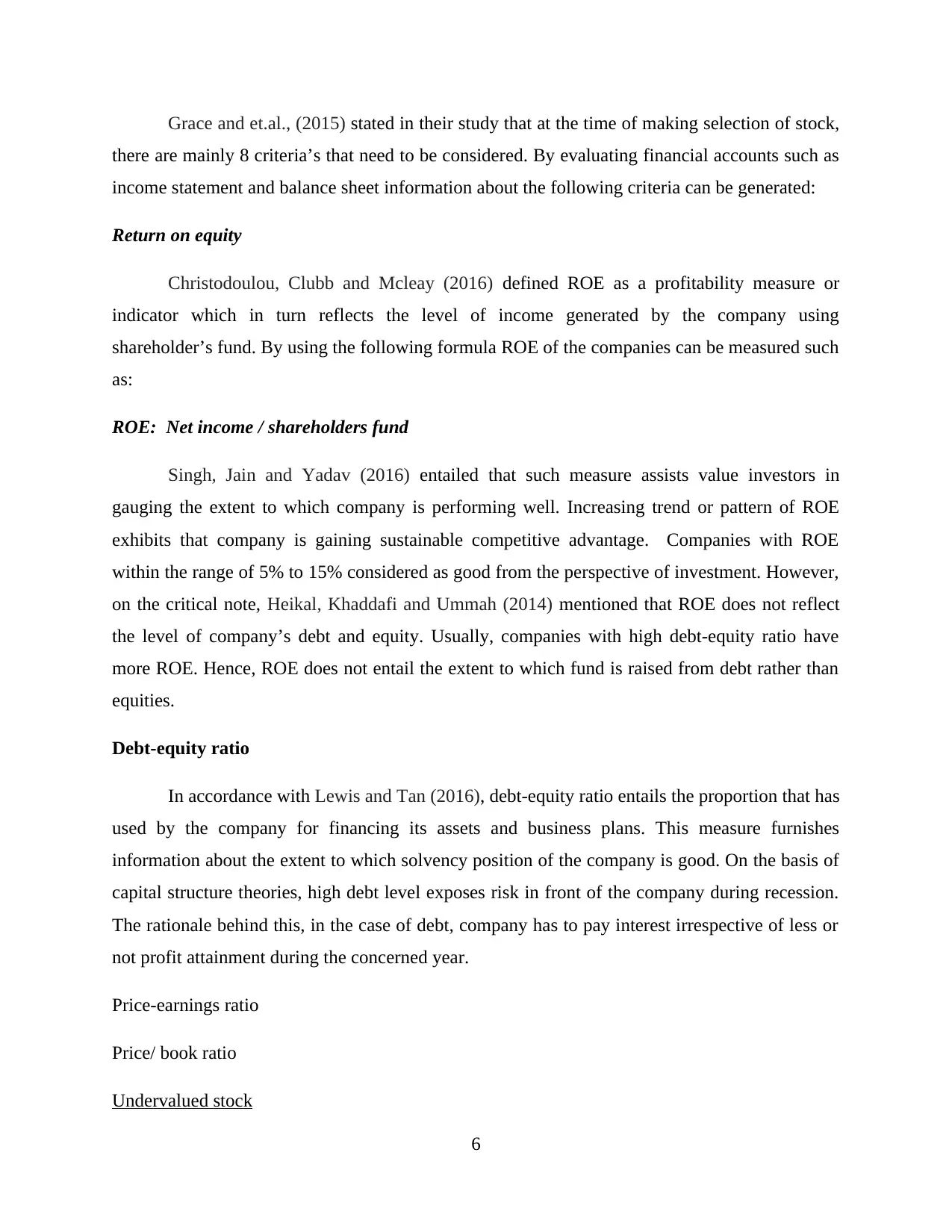
Grace and et.al., (2015) stated in their study that at the time of making selection of stock,
there are mainly 8 criteria’s that need to be considered. By evaluating financial accounts such as
income statement and balance sheet information about the following criteria can be generated:
Return on equity
Christodoulou, Clubb and Mcleay (2016) defined ROE as a profitability measure or
indicator which in turn reflects the level of income generated by the company using
shareholder’s fund. By using the following formula ROE of the companies can be measured such
as:
ROE: Net income / shareholders fund
Singh, Jain and Yadav (2016) entailed that such measure assists value investors in
gauging the extent to which company is performing well. Increasing trend or pattern of ROE
exhibits that company is gaining sustainable competitive advantage. Companies with ROE
within the range of 5% to 15% considered as good from the perspective of investment. However,
on the critical note, Heikal, Khaddafi and Ummah (2014) mentioned that ROE does not reflect
the level of company’s debt and equity. Usually, companies with high debt-equity ratio have
more ROE. Hence, ROE does not entail the extent to which fund is raised from debt rather than
equities.
Debt-equity ratio
In accordance with Lewis and Tan (2016), debt-equity ratio entails the proportion that has
used by the company for financing its assets and business plans. This measure furnishes
information about the extent to which solvency position of the company is good. On the basis of
capital structure theories, high debt level exposes risk in front of the company during recession.
The rationale behind this, in the case of debt, company has to pay interest irrespective of less or
not profit attainment during the concerned year.
Price-earnings ratio
Price/ book ratio
Undervalued stock
6
there are mainly 8 criteria’s that need to be considered. By evaluating financial accounts such as
income statement and balance sheet information about the following criteria can be generated:
Return on equity
Christodoulou, Clubb and Mcleay (2016) defined ROE as a profitability measure or
indicator which in turn reflects the level of income generated by the company using
shareholder’s fund. By using the following formula ROE of the companies can be measured such
as:
ROE: Net income / shareholders fund
Singh, Jain and Yadav (2016) entailed that such measure assists value investors in
gauging the extent to which company is performing well. Increasing trend or pattern of ROE
exhibits that company is gaining sustainable competitive advantage. Companies with ROE
within the range of 5% to 15% considered as good from the perspective of investment. However,
on the critical note, Heikal, Khaddafi and Ummah (2014) mentioned that ROE does not reflect
the level of company’s debt and equity. Usually, companies with high debt-equity ratio have
more ROE. Hence, ROE does not entail the extent to which fund is raised from debt rather than
equities.
Debt-equity ratio
In accordance with Lewis and Tan (2016), debt-equity ratio entails the proportion that has
used by the company for financing its assets and business plans. This measure furnishes
information about the extent to which solvency position of the company is good. On the basis of
capital structure theories, high debt level exposes risk in front of the company during recession.
The rationale behind this, in the case of debt, company has to pay interest irrespective of less or
not profit attainment during the concerned year.
Price-earnings ratio
Price/ book ratio
Undervalued stock
6

CHAPTER 3: RESEARCH METHODOLOGY
Research type
Qualitative and quantitative are the main two research types that scholar can select by
taking into account issue. Appropriate selection of research type is highly needed because further
techniques related to data collection and analysis highly influences from the same. Qualitative
research implies for the inquiry that develops understanding about human and social sciences. In
this, subjective approach and inductive reasoning is followed by the scholar. Such research helps
in exploring and discovering ideas that used in the n
Research approach
Research philosophy
Data collection
In the field of research, primary and secondary are the main two sources that can be used
for the purpose of data collection. Primary data is the one that researcher specifically gathers for
meeting research aim and objectives via survey, observation, focus group, interview etc. On the
contrary to this, secondary data refers to the one that has already been gathered and analyzed by
other researchers. Hence, for the purpose of doing value investing analysis data has been
gathered by the researcher from secondary sources. Hence, data pertaining to profitability,
liquidity, solvency and efficiency has been collected from the financial statements of 12 selected
companies operating in different sectors. Hence, by evaluating 5 years annual reports, from 2013
to 2017, data pertaining to the financial performance of the companies such as British Petroleum,
Dutch Shell, GSK, Astra Zeneca, Barclays, HSBC, Kingfisher, Next plc, Carnival and Easy jet
has been collected. In addition to this, for analyzing issue in the best possible way and presenting
suitable solution of the problem data has been gathered from London stock exchange regarding
share prices.
Sampling
Data analysis
Tools and techniques of data analysis are highly significant which in turn provides high
level of assistance in discovering suitable information from data set. Selection of tools and
7
Research type
Qualitative and quantitative are the main two research types that scholar can select by
taking into account issue. Appropriate selection of research type is highly needed because further
techniques related to data collection and analysis highly influences from the same. Qualitative
research implies for the inquiry that develops understanding about human and social sciences. In
this, subjective approach and inductive reasoning is followed by the scholar. Such research helps
in exploring and discovering ideas that used in the n
Research approach
Research philosophy
Data collection
In the field of research, primary and secondary are the main two sources that can be used
for the purpose of data collection. Primary data is the one that researcher specifically gathers for
meeting research aim and objectives via survey, observation, focus group, interview etc. On the
contrary to this, secondary data refers to the one that has already been gathered and analyzed by
other researchers. Hence, for the purpose of doing value investing analysis data has been
gathered by the researcher from secondary sources. Hence, data pertaining to profitability,
liquidity, solvency and efficiency has been collected from the financial statements of 12 selected
companies operating in different sectors. Hence, by evaluating 5 years annual reports, from 2013
to 2017, data pertaining to the financial performance of the companies such as British Petroleum,
Dutch Shell, GSK, Astra Zeneca, Barclays, HSBC, Kingfisher, Next plc, Carnival and Easy jet
has been collected. In addition to this, for analyzing issue in the best possible way and presenting
suitable solution of the problem data has been gathered from London stock exchange regarding
share prices.
Sampling
Data analysis
Tools and techniques of data analysis are highly significant which in turn provides high
level of assistance in discovering suitable information from data set. Selection of tools and
7

techniques highly vary in accordance with the type of research undertaken. Usually, in
qualitative investigation focus is placed by the researcher on undertaking thematic perception test
technique. On the other side, for quantitative data set or evaluation SPSS and other statistical &
financial tools are employed. In this, ratio analysis tool has been employed for evaluating
financial position and performance of the selected companies from several perspectives.
Research limitations
Reliability and validity
Ethical considerations
8
qualitative investigation focus is placed by the researcher on undertaking thematic perception test
technique. On the other side, for quantitative data set or evaluation SPSS and other statistical &
financial tools are employed. In this, ratio analysis tool has been employed for evaluating
financial position and performance of the selected companies from several perspectives.
Research limitations
Reliability and validity
Ethical considerations
8
Secure Best Marks with AI Grader
Need help grading? Try our AI Grader for instant feedback on your assignments.

CHAPTER 4: DATA ANALYSIS AND FINDINGS
9
9

CHAPTER 5: CONCLUSION AND RECOMMENDATIONS
10
10

REFERENCES
Books and Journals
Betermier, S., Calvet, L. E. and Sodini, P., 2017. Who are the value and growth investors?. The
Journal of Finance. 72(1). pp.5-46.
Bogle, J. C., 2017. The Little Book of Common Sense Investing: The Only Way to Guarantee
Your Fair Share of Stock Market Returns. John Wiley & Sons.
Christodoulou, D., Clubb, C. and Mcleay, S., 2016. A structural accounting framework for
estimating the expected rate of return on equity. Abacus. 52(1). pp.176-210.
Cronqvist, H., Siegel, S. and Yu, F., 2015. Value versus growth investing: Why do different
investors have different styles?. Journal of Financial Economics. 117(2). pp.333-349.
Davis, P., 2017. Value Investing: Do Quant Strategies Measure Up?. In Practice, 2(1).
Grace, M. F. and et.al., 2015. The value of investing in enterprise risk management. Journal of
Risk and Insurance, 82(2), pp.289-316.
Heikal, M., Khaddafi, M. and Ummah, A., 2014. Influence analysis of return on assets (ROA),
return on equity (ROE), net profit margin (NPM), debt to equity ratio (DER), and current
ratio (CR), against corporate profit growth in automotive in Indonesia Stock
Exchange. International Journal of Academic Research in Business and Social
Sciences. 4(12). p.101.
Kok, U. W., Ribando, J. and Sloan, R., 2017. Facts about formulaic value investing. Financial
Analysts Journal. 73(2). pp.81-99.
Lewis, C. M. and Tan, Y., 2016. Debt-equity choices, R&D investment and market
timing. Journal of Financial Economics. 119(3). pp.599-610.
Schuler, D. A. and et.al., 2017. Windfalls of emperors' sojourns: Stock market reactions to
Chinese firms hosting high‐ranking government officials. Strategic Management
Journal. 38(8). pp.1668-1687.
11
Books and Journals
Betermier, S., Calvet, L. E. and Sodini, P., 2017. Who are the value and growth investors?. The
Journal of Finance. 72(1). pp.5-46.
Bogle, J. C., 2017. The Little Book of Common Sense Investing: The Only Way to Guarantee
Your Fair Share of Stock Market Returns. John Wiley & Sons.
Christodoulou, D., Clubb, C. and Mcleay, S., 2016. A structural accounting framework for
estimating the expected rate of return on equity. Abacus. 52(1). pp.176-210.
Cronqvist, H., Siegel, S. and Yu, F., 2015. Value versus growth investing: Why do different
investors have different styles?. Journal of Financial Economics. 117(2). pp.333-349.
Davis, P., 2017. Value Investing: Do Quant Strategies Measure Up?. In Practice, 2(1).
Grace, M. F. and et.al., 2015. The value of investing in enterprise risk management. Journal of
Risk and Insurance, 82(2), pp.289-316.
Heikal, M., Khaddafi, M. and Ummah, A., 2014. Influence analysis of return on assets (ROA),
return on equity (ROE), net profit margin (NPM), debt to equity ratio (DER), and current
ratio (CR), against corporate profit growth in automotive in Indonesia Stock
Exchange. International Journal of Academic Research in Business and Social
Sciences. 4(12). p.101.
Kok, U. W., Ribando, J. and Sloan, R., 2017. Facts about formulaic value investing. Financial
Analysts Journal. 73(2). pp.81-99.
Lewis, C. M. and Tan, Y., 2016. Debt-equity choices, R&D investment and market
timing. Journal of Financial Economics. 119(3). pp.599-610.
Schuler, D. A. and et.al., 2017. Windfalls of emperors' sojourns: Stock market reactions to
Chinese firms hosting high‐ranking government officials. Strategic Management
Journal. 38(8). pp.1668-1687.
11
Paraphrase This Document
Need a fresh take? Get an instant paraphrase of this document with our AI Paraphraser

Singh, S., Jain, P. K. and Yadav, S. S., 2016. Rates of Return on Equity Funds (ROEF)—
Corporates’ Perspective. In Equity Markets in India (pp. 33-43). Springer, Singapore.
12
Corporates’ Perspective. In Equity Markets in India (pp. 33-43). Springer, Singapore.
12
1 out of 14
Related Documents
Your All-in-One AI-Powered Toolkit for Academic Success.
+13062052269
info@desklib.com
Available 24*7 on WhatsApp / Email
![[object Object]](/_next/static/media/star-bottom.7253800d.svg)
Unlock your academic potential
© 2024 | Zucol Services PVT LTD | All rights reserved.





